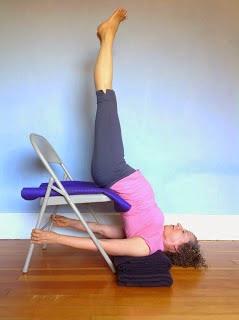by Nina
 Although you might think of an “inverted” yoga pose as one where you are completely upside down, such as Handstand, Headstand, and Shoulderstand, any yoga pose where your heart is higher than your head is considered an inverted pose. That means there are three basic types of inversions:
Although you might think of an “inverted” yoga pose as one where you are completely upside down, such as Handstand, Headstand, and Shoulderstand, any yoga pose where your heart is higher than your head is considered an inverted pose. That means there are three basic types of inversions:- Full inversions, where your whole body is completely inverted, as in Headstand.
- Partial inversions, where your heart is directly above your head (or almost) but only part of your body is inverted, as in Standing Forward Bend (Uttanasana), Wide-Legged Forward Bend (Prasarita Padottanasana), and Plow pose.
- Gentle inversions, where your heart is only slightly above your head, as in Bridge pose, Downward-Facing Dog pose, and Legs Up the Wall pose.
The reason we group all these poses together is that any pose where your heart is higher than your head has a special quieting effect on your nervous system, which makes the poses especially calming (assuming you are comfortable in the pose, of course). You can find out why this happens in my post Why You Should Love Your Baroreceptors They are also good for heart health and circulation as gravity helps return venous fluids back to your heart (see Appreciating Your Entire Cardiovascular System).Personally, I love all these poses and have found practicing them very beneficial for times when I’m feeling stressed. And because these poses are also beneficial for circulation, especially when your legs are inverted, I’ve been practicing them regularly for my varicose veins. However, some of the full inverted poses, such as Headstand and Shoulderstand, can pose risks for certain people. And not everyone should be practicing poses that affect their blood pressure (which inversions do). Don’t panic, however, as you’ll find that most people can safely do the gentle inversions, no matter what. Fortunately, we have a lot of information on our blog on the benefits of these poses, how to practice them, and safety issues related to them.First, I’ll start with background information about the poses themselves. Maybe this will help you discover some new ways to reduce your stress! Then I’ll provide links to the articles on inverted poses and sequences that utilize them. Finally, I’ll conclude with posts about cautions and safety issues for practicing them. About Inverted PosesIn Just in Time for the Holidays I discuss the value of practicing inverted poses and why I’m such a fan of them.In Why You Should Love Your Baroreceptors I provide the anatomical/medical background that explains exactly why inverted poses can be so calming for your nervous system.In Techniques for Improving Cardiovascular and Heart Health Baxter and I provide tips for using inverted poses for heart and cardiovascular health.In All About Supported Inversions I discuss the value of practicing the supported versions of all the inverted poses and provide photos and descriptions of all of them.In Low Pressure Tactics Victor describes how he practiced inverted poses, among other things, to help lower his blood pressure.Practicing Inverted PosesBecause we don’t want to instruct people via writing about how to practice full Headstand, Shoulderstand, and Plow pose, we don’t have information on how to practice those on our poses on our blog. For instructions, you should consult an experienced teacher who can teach you in person. However, we do have information on the supported versions of Shoulderstand and Plow. Here are the posts that describe how to do individual poses:Featured Pose: Downward-Facing Dog Pose (For Downward-Facing Dog pose with head support, see Featured Sequence: Easy Supported Inverted Practice.)
Featured Pose: Standing Forward Bend Featured Pose: Wide-Legged Forward Bend
Featured Pose: Chair Shoulderstand
Featured Pose: Half Plow Pose
Featured Pose: Bridge Pose
Featured Pose: Legs Up the Wall Pose
Featured Pose: Easy Inverted Pose Here are two sequences that use inverted poses:
Featured Sequence: Easy Supported Inverted PracticeFeatured Sequence: Inverted Heart Health Practice
See All About Supported Inversions for recommendations on how to sequence inverted poses.
Safety and Inverted PosesIn Friday Q&A: Caution for Inversions I provide information about who should not be practicing which inverted poses or who should approach them with caution.In How to Stay Safe While Practicing Yoga I provide generally information about staying safe while practicing yoga, all of which applies to the inverted poses.In the following posts, Baxter addresses safety issues related specifically to Headstand:Friday Q&A: The Safety of Headstand (Sirsasana)Friday Q&A: Ostepenia of the Spine and Headstand Friday Q&A: Implantable Cardioverter Defibrillators (ICD) and YogaSubscribe to Yoga for Healthy Aging by Email ° Follow Yoga for Healthy Aging on Facebook and Twitter ° To order Yoga for Healthy Aging: A Guide to Lifelong Well-Being, go to Amazon, Shambhala, Indie Bound or your local bookstore.For information about Nina's upcoming book signings and other activities, see Nina's Workshops, Book Signings, and Books.

